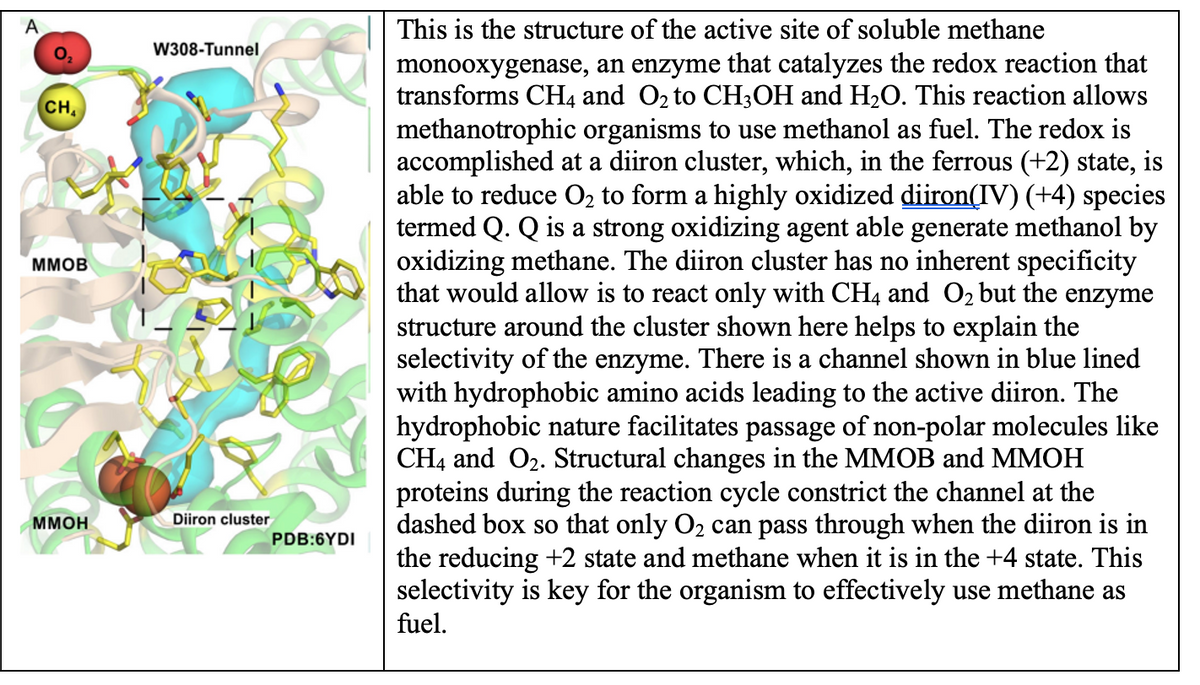The structure of a metalloenzyme active site is down below(black picture). Describe, from a chemical and structural perspective, how the reactive site is designed to facilitate its catalytic reaction. The example below(white pitcure) suggests the level of detail that is required. Make sure that you explain what the metal is doing, what the reaction is, and its biological significance.
The structure of a metalloenzyme active site is down below(black picture). Describe, from a chemical and structural perspective, how the reactive site is designed to facilitate its catalytic reaction. The example below(white pitcure) suggests the level of detail that is required. Make sure that you explain what the metal is doing, what the reaction is, and its biological significance.
Biochemistry
6th Edition
ISBN:9781305577206
Author:Reginald H. Garrett, Charles M. Grisham
Publisher:Reginald H. Garrett, Charles M. Grisham
Chapter18: Glycolysis
Section: Chapter Questions
Problem 13P
Related questions
Question
The structure of a metalloenzyme active site is down below(black picture). Describe, from a chemical and structural perspective, how the reactive site is designed to facilitate its catalytic reaction. The example below(white pitcure) suggests the level of detail that is required. Make sure that you explain what the metal is doing, what the reaction is, and its biological significance.

Transcribed Image Text:A
CH
MMOB
MMOH
W308-Tunnel
Diiron cluster
PDB:6YDI
This is the structure of the active site of soluble methane
monooxygenase, an enzyme that catalyzes the redox reaction that
transforms CH4 and O₂ to CH3OH and H₂O. This reaction allows
methanotrophic organisms to use methanol as fuel. The redox is
accomplished at a diiron cluster, which, in the ferrous (+2) state, is
able to reduce O₂ to form a highly oxidized diiron(IV) (+4) species
termed Q. Q is a strong oxidizing agent able generate methanol by
oxidizing methane. The diiron cluster has no inherent specificity
that would allow is to react only with CH4 and O₂ but the enzyme
structure around the cluster shown here helps to explain the
selectivity of the enzyme. There is a channel shown in blue lined
with hydrophobic amino acids leading to the active diiron. The
hydrophobic nature facilitates passage of non-polar molecules like
CH4 and O₂. Structural changes in the MMOB and MMOH
proteins during the reaction cycle constrict the channel at the
dashed box so that only O₂ can pass through when the diiron is in
the reducing +2 state and methane when it is in the +4 state. This
selectivity is key for the organism to effectively use methane as
fuel.
![A
B
172
spmoB
265
spmoBd2
spmoBd1
See this image and copyright information in PMC
Figure 1 Overall architecture of pMMO. (A) Structure of Methylocystis sp. strain M pMMO
protomer (PDB accession code 3RGR). The pmoB, pmoA, and pmoC subunits are shown in
blue, magenta, and green, respectively. The N- and C-termini of pmoB are labeled. An
exogenous helix is shown in yellow. Copper ions are shown as cyan spheres and a zinc ion is
shown as a gray sphere. Ligands are shown as ball-and-stick representations. (B) Structure of
M. capsulatus (Bath) pMMO protomer (PDB accession code 3RGB). The amino terminal
domain of pmoB (spmoBd1) is shown in blue, the carboxy terminal domain of pmoB is shown
in gray (spmoBd2), and the two transmembrane helices are shown in transparent blue. In the
recombinant spmoB protein, spmoBd1 and spmoBd2 are linked by a GKLGGG sequence
connecting residues 172 and 265 (labeled). The pmoA and pmoC subunits are shown in
transparent magenta and transparent green, respectively. A hydrophilic patch of residues
proposed to house a tricopper active site is denoted with an asterisk. The mononuclear
copper site at the interface of the two spmoB domains is not present in the Methylocystis sp.
strain M pMMO structure. [A color version of this figure is available online.]](/v2/_next/image?url=https%3A%2F%2Fcontent.bartleby.com%2Fqna-images%2Fquestion%2Fd2705ec0-2034-4d28-a385-06c28bb62d2f%2F391b8bed-783a-4c57-aef8-6d7ec2f290bf%2Fye45v4b_processed.png&w=3840&q=75)
Transcribed Image Text:A
B
172
spmoB
265
spmoBd2
spmoBd1
See this image and copyright information in PMC
Figure 1 Overall architecture of pMMO. (A) Structure of Methylocystis sp. strain M pMMO
protomer (PDB accession code 3RGR). The pmoB, pmoA, and pmoC subunits are shown in
blue, magenta, and green, respectively. The N- and C-termini of pmoB are labeled. An
exogenous helix is shown in yellow. Copper ions are shown as cyan spheres and a zinc ion is
shown as a gray sphere. Ligands are shown as ball-and-stick representations. (B) Structure of
M. capsulatus (Bath) pMMO protomer (PDB accession code 3RGB). The amino terminal
domain of pmoB (spmoBd1) is shown in blue, the carboxy terminal domain of pmoB is shown
in gray (spmoBd2), and the two transmembrane helices are shown in transparent blue. In the
recombinant spmoB protein, spmoBd1 and spmoBd2 are linked by a GKLGGG sequence
connecting residues 172 and 265 (labeled). The pmoA and pmoC subunits are shown in
transparent magenta and transparent green, respectively. A hydrophilic patch of residues
proposed to house a tricopper active site is denoted with an asterisk. The mononuclear
copper site at the interface of the two spmoB domains is not present in the Methylocystis sp.
strain M pMMO structure. [A color version of this figure is available online.]
Expert Solution
This question has been solved!
Explore an expertly crafted, step-by-step solution for a thorough understanding of key concepts.
This is a popular solution!
Trending now
This is a popular solution!
Step by step
Solved in 2 steps with 1 images

Recommended textbooks for you

Biochemistry
Biochemistry
ISBN:
9781305577206
Author:
Reginald H. Garrett, Charles M. Grisham
Publisher:
Cengage Learning

Biology 2e
Biology
ISBN:
9781947172517
Author:
Matthew Douglas, Jung Choi, Mary Ann Clark
Publisher:
OpenStax

Biochemistry
Biochemistry
ISBN:
9781305577206
Author:
Reginald H. Garrett, Charles M. Grisham
Publisher:
Cengage Learning

Biology 2e
Biology
ISBN:
9781947172517
Author:
Matthew Douglas, Jung Choi, Mary Ann Clark
Publisher:
OpenStax